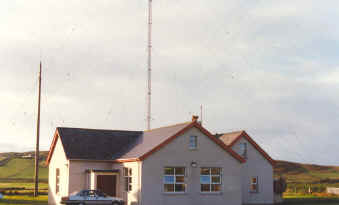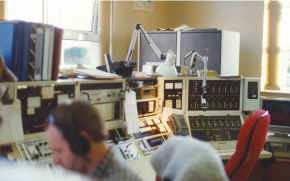| MARITIME RADIO STATIONS OF THE WORLD
l IRELAND
|
MALINHEAD RADIO/EJMex-GMH ex-MH
In 1912, with the station now operated by the United Kingdom General Post Office's Wireless Telegraphy Section, the callsign changed to "GMH" to reflect the change to national identity in callsigns. Even with the formation of the Irish Free State the station retained it's GMH callsign since Eire was part of the British Commonwealth. But on 1st January 1951, following Ireland's withdrawal from the Commonwealth to become a Republic, the station again changed callsign, reflecting the nation's identity, to "EJM". For many years the station was primarily a WT (Morse Code) station operating in the 500kHz band. Although telephony facilities were available on 2182kHz and 1841kHz, the station could not offer shipping a "link-call" service - this was something which always mystified those in the UK Coast Station service since EJM had superb coverage of the North Western approaches to the British Isles. There was a practical problem to providing such a service and that was the antiquity of much of the Irish Republic's telephone service. The telephone at EJM was once described as the lines strung out over the bogs (and often brought down by the gales) with the telephone having, as in the old Western movies, a microphone built into the main body of the telephone, a separate earpiece and a handle to turn to call the operator!
The end of one era for EJM came at 2359 hours GMT on 31st December 1988 when the WT (Morse Code) service on 500 and 421kHz closed down. A tape recording was made of the final broadcast and farewells from other coast radio stations - and, as the echo of the final tone of the key died away, the sadness of this event could been heard in the voices of the duty Radio Officer's with a background comment of "it's gone". It might be argued that the Irish authorities were rather early in closing the 500kHz from such a strategically positioned station. Indeed there was one incident when the station's 500kHz automatic alarm receiver, which remained on watch, was activated by the signals of a sinking ship far out in the Atlantic. EJM was the only station able to copy the weak signals from the ship's lifeboat and, with the station's transmitters dismantled, return transmissions had to be made by her sister station Valentia Radio/EJK - not the most ideal means of conducting a distress situation. (NOTE:- EJM's callsign "mysteriously" re-appeared twice again on 500kHz. Once when, late on the evening of 31st January 1997, the station participated in the historic closedown of the United Kingdom's 500kHz service. Then again late on the 31st January 1999 into the early hours of 1st February 1999 - "GMDSS day" - the day when Morse Code ceased to be part of the international distress system for shipping)
Unlike the United Kingdom, the Irish Republic has no Coastguard system. There was however a need for a Search and Rescue Coordination organisation. It was determined that this should be based on the Coast Radio Station service. A Maritime Rescue Coordination Centre was set up in Dublin with the introduction of a NEW Coast Radio Station "Dublin Radio" operating on VHF only. At Malinhead and Valentia the Radio Officers, already well aquainted with and highly professional in handling distress and safety communications, took on the additional task of coordination of rescue effort and the GMDSS facility of DSC (digital selective calling) was added to the station's facilities.
The future looks good for Malinhead Radio. And, with the Republic's decision to base their coordination on professional communicators using professional equipment, those who sail the northwest Atlantic can be assured they are in good hands. The Radio Officer on duty in the above photographs is Mike Mullins - see Mike's homepage at http://ireland.iol.ie/~mmullins. My thanks to him and to Finbar O'Conner who entertained me during that particular visit. Thanks also to the others I've met during other visits to the station and those who assisted GTST with WT, RT and DSC tests in my Radio Surveyor days. For more photographs and even more information on EJM take a look here |

 MALINHEAD
RADIO was opened in June 1902 by the Marconi Marine
Company with the appropriate callsign "MH".
MALINHEAD
RADIO was opened in June 1902 by the Marconi Marine
Company with the appropriate callsign "MH".  Joining
the EEC brought money into Ireland, including into the Republic's telephone
network. Malinhead Radio was, somewhat belatedly, brought into the "modern"
age of telephone link calls! Further expansion followed with the introduction
of VHF services from Malinhead and a number of remote stations.
Joining
the EEC brought money into Ireland, including into the Republic's telephone
network. Malinhead Radio was, somewhat belatedly, brought into the "modern"
age of telephone link calls! Further expansion followed with the introduction
of VHF services from Malinhead and a number of remote stations.  The
closure of EJM's 500KHz WT service came as a result of the gradual introduction
of GMDSS (the Global Maritime Distress and Safety System) in which Morse
Code plays no part. But this new system has, unlike Coast Radio Stations
in many other countries, given Malinhead Radio a new lease of life.
The
closure of EJM's 500KHz WT service came as a result of the gradual introduction
of GMDSS (the Global Maritime Distress and Safety System) in which Morse
Code plays no part. But this new system has, unlike Coast Radio Stations
in many other countries, given Malinhead Radio a new lease of life.
 The
plan for the future is that Malinhead, Valentia and Dublin control centres
will have facilities to take control of equipment at each other's stations.
Some of this is already in place and means that, should it ever become
necessary, the workload, whether safety related or commercial, could
be spread.
The
plan for the future is that Malinhead, Valentia and Dublin control centres
will have facilities to take control of equipment at each other's stations.
Some of this is already in place and means that, should it ever become
necessary, the workload, whether safety related or commercial, could
be spread.